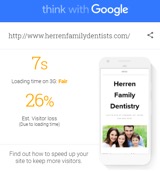Should I Respond to Negative Reviews?
 At ProspectaMarketing, we know mistakes happen. Sometimes, a patient coming to your dental practice has to wait an undue amount of time, runs into a scheduling issue, or is simply unhappy with treatment. If you have been closely monitoring your reviews, as we’ve detailed in our previous blog posts, the possibility of a bad one might be making you cringe.
At ProspectaMarketing, we know mistakes happen. Sometimes, a patient coming to your dental practice has to wait an undue amount of time, runs into a scheduling issue, or is simply unhappy with treatment. If you have been closely monitoring your reviews, as we’ve detailed in our previous blog posts, the possibility of a bad one might be making you cringe.
We encourage you to see this as a positive moment. But in order to take full advantage of it, there are some things you need to accept. Yes, the customer is dissatisfied with the service you’ve provided. Most likely, they are going to leave a review. And yes, there’s a high probability that people will see the review.
According to BrightLocal’s 2022 Consumer Review Survey, 98% of people at least “occasionally” read online reviews. 77% of consumers ‘always’ or ‘regularly’ read online reviews. The percentage of people ‘never’ reading reviews, on the other hand, has dropped to an all-time low of 2%. Furthermore, 7% of people leave reviews for bad experiences, and a whopping 33% leave them for good AND bad experiences. So patient feedback counts for a lot!
It’s easy to tell what this means: If you have any sort of digital presence, chances are people are reading your reviews in order to choose between your practice and a competitor, and bad reviews will lead them to ignore your practice, if no action is taken.
What To Do About Bad Reviews
This can be alarming if you have any bad reviews, as the first thought is that a massive amount of people will see them. Indeed, online reviews play a major role in creating and maintaining consumer trust in the healthcare industry. 83% of those polled indicated that reviews played a ‘very important’ or ‘important’ part in their choice of healthcare provider.
But here’s the good bit: you can turn it around! The same survey details that 80% of consumers will leave a positive review if they initially had a negative experience, but it was turned into a positive experience. There’s no better way to curtail bad reviews than by having the same customer leave a good one that states how their issues were fixed during a follow-up appointment.
Our suggestion is to always read negative reviews in order to ascertain what went wrong. Don’t write them off as occasional messages from disgruntled customers that are simply pouting. Learn from them. This way, you can ensure the problems never repeat and the patient leaves positive feedback following future appointments.
But should you respond to negative reviews? BrightLocal says yes! Respond to all reviews, positive and negative. When asked which factors of online reviews would make them feel positively about a practice, 55% of people said that the business owner responding to the review was vital. Similarly, when asked how likely they were to use a business that deals with responses in a variety of ways, 89% of people said that they were ‘highly’ or ‘fairly’ likely to use one that responds to all reviews.
How To Respond
- Don’t Be Defensive: Respond to every negative review with kindness, direct information, and professionalism. Understand that this is not a personal attack on you or your team, but simply a case of a customer letting a business know how it can improve its services.
- Keep It Accurate: If a patient’s complaints are inaccurate, or somehow don’t reflect what actually occurred during the appointment, do not respond as you would in an argument. Experiences are filtered through our unique, subjective perspectives, and what one person might see as an egregious offense, another might see as a small nuisance. Give your patients the benefit of the doubt, don’t attack them, but do make sure to clearly state what actually happened, so other patients can understand the situation. Offer apologies for their negative experience and commit to making their next appointment a positive one.
- Grammar Counts: People often see poor grammar and written mistakes as indicative of a lack of professionalism. And why shouldn’t they? If your practice is to be an authority on healthcare in any capacity, the information patients receive from you must be correctly and accurately transmitted, and so must your responses to patient feedback.
- Respond Quickly: Don’t let reviews, good or bad, sit in the queue unanswered. When asked which factors would make them feel positively, 49% of those polled by BrightLocal stated that the review being posted within the last month was important. This means about half of your patients are reading recent reviews and deciding to use your services based on them. If a negative review was recently written, it is important to respond to it in a timely fashion, so that anybody sorting by ‘Most Recent’ can see the lengths you’ve gone to in order to fix the issue.
The verdict is in: responding to reviews helps build up consumer trust and improves communication between practice and patient. Don’t let a negative review get you down. It is yet another marketing opportunity you can use to make sure you’re getting the right message out.
At ProspectaMarketing, we can help manage your review responses for you! We are an experienced Internet marketing firm specializing in dental practices and the tools of Internet marketing. We help you reach key prospects who are looking for what your practice has to offer. Our unique and thorough approach provides visibility, financial accountability, and ongoing refinement and improvement. You can find out more by contacting Lane Anderson toll-free at 1-877-322-4440 Ext 101, by email using the form on our Contact Us page, or online at ProspectaMarketing.com.



